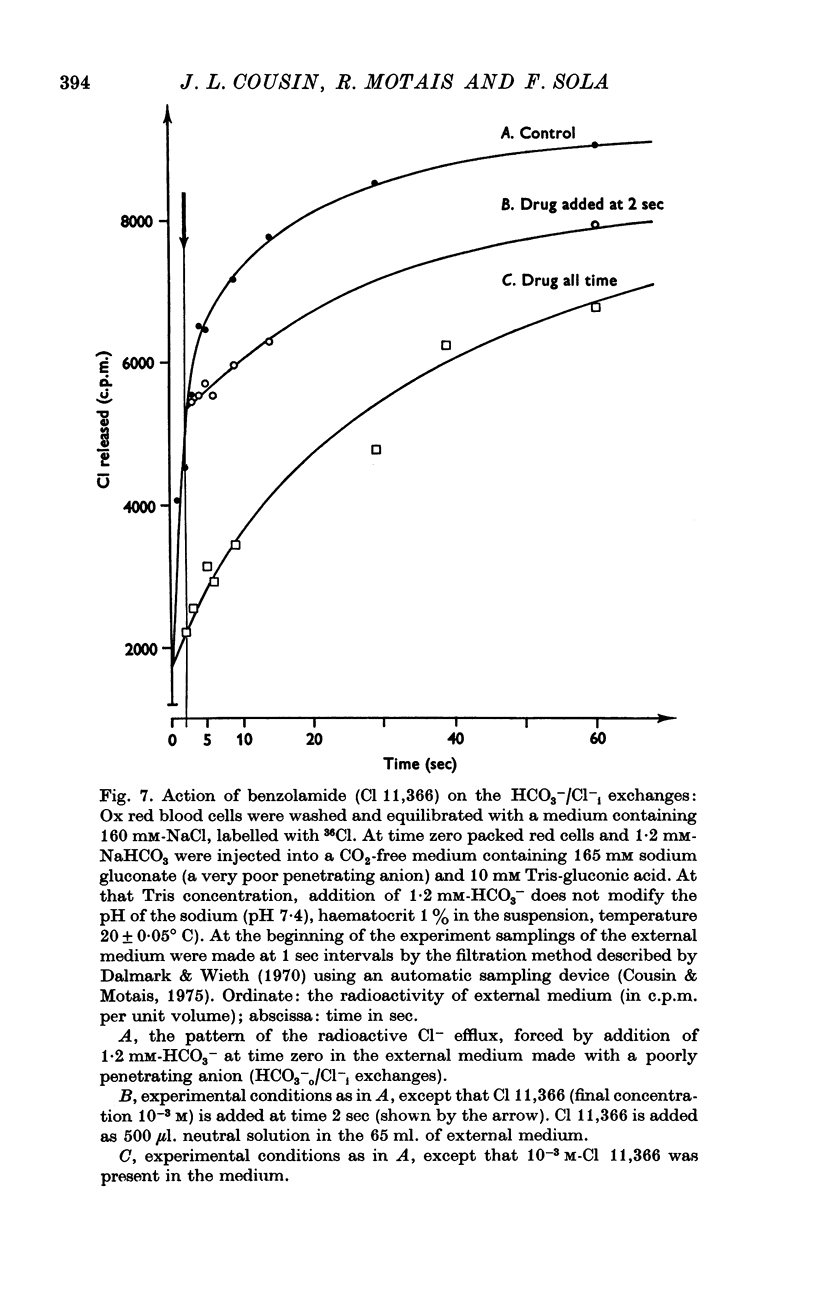Abstract
1. It is well known that red blood cells suspended in isotonic NH4Cl solution swell because penetration of NH3 induces a transmembrane exchange between Cl-o and OH-i(or HCO3-i). The rate of swelling thus depends on the speed of the transmembrane exchanges and on the amount of anions available for exchange. 2. It has been demonstrated in experiments carried out in a CO2-free medium that OH-ions are poorly permeating whereas the permeability for HCO3-is very high. Thus the rate of swelling is largely dependent on the intracellular HCO3-concentration. In this context the well-known inhibitory effect of sulphonamides upon swelling can be interpreted, and always has been until now, as being due to the inhibitory action of the drug on the intracellular carbonic anhydrase. However, this inhibitory effect could also result from a direct action of the drug on the transmembrane exchange; it would explain why under conditions of total carbonic anhydrase inhibition we have shown that the inhibition of swelling is far from maximal. 3. A direct experimental evidence of such an effect of carbonic anhydrase inhibitors on the transmembrane exchange of Cl-with HCO3- was obtained with benzolamide (Cl 11,366), Cl 13,580 and ethoxzolamide. Surprisingly enough, however, acetazolamide (Diamox) does not affect the transmembrane exchange process. 4. The inhibitory effect of sulphonamides on HCO3-transport process is discussed in terms of an interaction of the drug with a transport system common to HCO3- and organic anions.
Full text
PDF














Selected References
These references are in PubMed. This may not be the complete list of references from this article.
- Adrian C., Hogben M. The chloride effect of carbonic anhydrase inhibitors. Mol Pharmacol. 1967 Jul;3(4):318–326. [PubMed] [Google Scholar]
- Aubert L., Motais R. Molecular features of organic anion permeablity in ox red blood cell. J Physiol. 1975 Mar;246(1):159–179. doi: 10.1113/jphysiol.1975.sp010884. [DOI] [PMC free article] [PubMed] [Google Scholar]
- Bodemann H., Passow H. Factors controlling the resealing of the membrane of human erythrocyte ghosts after hypotonic hemolysis. J Membr Biol. 1972;8(1):1–26. doi: 10.1007/BF01868092. [DOI] [PubMed] [Google Scholar]
- Booth V. H. Carbonic anhydrase activity inside corpuscles. Enzyme-substrate accessibility factors. J Physiol. 1938 Jul 14;93(2):117–128. doi: 10.1113/jphysiol.1938.sp003630. [DOI] [PMC free article] [PubMed] [Google Scholar]
- Cabantchik Z. I., Rothstein A. The nature of the membrane sites controlling anion permeability of human red blood cells as determined by studies with disulfonic stilbene derivatives. J Membr Biol. 1972 Dec 29;10(3):311–330. doi: 10.1007/BF01867863. [DOI] [PubMed] [Google Scholar]
- Cotterrell D., Whittam R. The influence of the chloride gradient across red cell membranes on sodium and potassium movements. J Physiol. 1971 May;214(3):509–536. doi: 10.1113/jphysiol.1971.sp009446. [DOI] [PMC free article] [PubMed] [Google Scholar]
- Dalmark M., Wieth J. O. Chloride and sodium permeabilities of human red cells. Biochim Biophys Acta. 1970 Dec 1;219(2):525–527. doi: 10.1016/0005-2736(70)90239-7. [DOI] [PubMed] [Google Scholar]
- Deuticke B. Anion permeability of the red blood cell. Naturwissenschaften. 1970 Apr;57(4):172–179. doi: 10.1007/BF00592968. [DOI] [PubMed] [Google Scholar]
- Gunn R. B., Dalmark M., Tosteson D. C., Wieth J. O. Characteristics of chloride transport in human red blood cells. J Gen Physiol. 1973 Feb;61(2):185–206. doi: 10.1085/jgp.61.2.185. [DOI] [PMC free article] [PubMed] [Google Scholar]
- Holder L. B., Hayes S. L. Diffusion of sulfonamides in aqueous buffers and into red cells. Mol Pharmacol. 1965 Nov;1(3):266–279. [PubMed] [Google Scholar]
- Istin M., Girard J. P. Carbonic anhydrase and mobilisation of calcium reserves in the mantle of lamellibranchs. Calcif Tissue Res. 1970;5(3):247–260. doi: 10.1007/BF02017553. [DOI] [PubMed] [Google Scholar]
- Jacobs M. H., Stewart D. R. THE ROLE OF CARBONIC ANHYDRASE IN CERTAIN IONIC EXCHANGES INVOLVING THE ERYTHROCYTE. J Gen Physiol. 1942 Mar 20;25(4):539–552. doi: 10.1085/jgp.25.4.539. [DOI] [PMC free article] [PubMed] [Google Scholar]
- Kitahara S., Fox K. R., Hogben C. A. Depression of chloride transport by carbonic anhydrase inhibitors in the absence of carbonic anhydrase. Nature. 1967 May 20;214(5090):836–837. doi: 10.1038/214836a0. [DOI] [PubMed] [Google Scholar]
- Knauf P. A., Rothstein A. Chemical modification of membranes. I. Effects of sulfhydryl and amino reactive reagents on anion and cation permeability of the human red blood cell. J Gen Physiol. 1971 Aug;58(2):190–210. doi: 10.1085/jgp.58.2.190. [DOI] [PMC free article] [PubMed] [Google Scholar]
- MAREN T. H., ROBINSON B., PALMER R. F., GRIFFITH M. E. The binding of aromatic sulfonamides to erythrocytes. Biochem Pharmacol. 1961 Apr;6:21–46. doi: 10.1016/0006-2952(61)90066-1. [DOI] [PubMed] [Google Scholar]
- Maren T. H., Wiley C. W. Kinetics of carbonic anhydrase in whole red cells as measured by transfer of carbon dioxide and ammonia. Mol Pharmacol. 1970 Jul;6(4):430–440. [PubMed] [Google Scholar]
- Meldrum N. U., Roughton F. J. Carbonic anhydrase. Its preparation and properties. J Physiol. 1933 Dec 5;80(2):113–142. doi: 10.1113/jphysiol.1933.sp003077. [DOI] [PMC free article] [PubMed] [Google Scholar]
- Motais R., Cousin J. L., Sola F. Les échanges transmembranaires de C1- et de HCO3- dans le globule rouge: mise en évidence d'une action directe des inhibiteurs de l'anhydrase carbonique sur le mécanisme de transfert. C R Acad Sci Hebd Seances Acad Sci D. 1975 Mar 3;280(9):1119–1122. [PubMed] [Google Scholar]
- Schultz S. G., Frizzell R. A., Nellans H. N. ION transport by mammalian small intestine. Annu Rev Physiol. 1974;36:51–91. doi: 10.1146/annurev.ph.36.030174.000411. [DOI] [PubMed] [Google Scholar]
- Selwyn M. J., Dawson A. P., Stockdale M., Gains N. Chloride-hydroxide exchange across mitochondrial, erythrocyte and artificial lipid membranes mediated by trialkyl- and triphenyltin compounds. Eur J Biochem. 1970 May 1;14(1):120–126. doi: 10.1111/j.1432-1033.1970.tb00268.x. [DOI] [PubMed] [Google Scholar]


